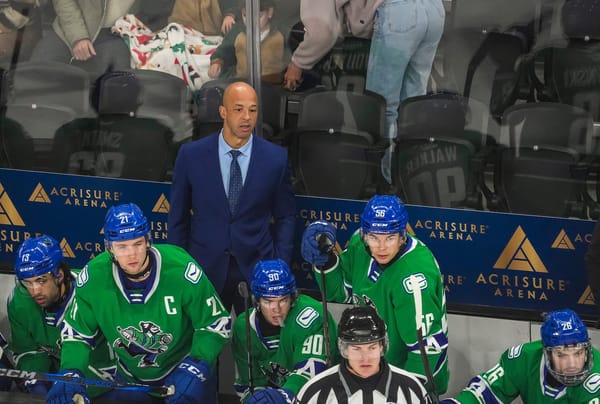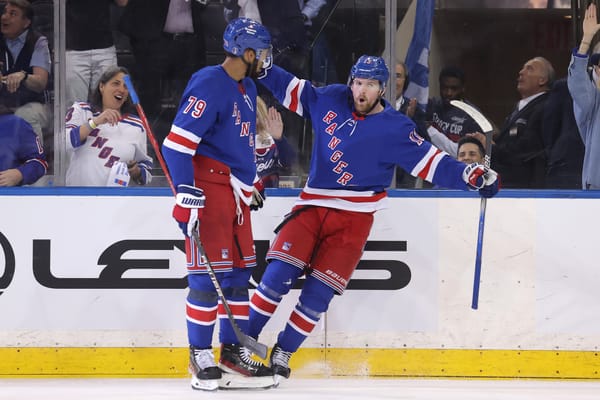Replacing Kevin Hayes Will Be Easier Said Than Done for New York Rangers
The trade of Kevin Hayes was widely expected, and the Rangers will have a tough time replacing what he brought to the team.
The Kevin Hayes era —half-decade or insert favorite phrase for passing of time — in New York is likely over, and it’s hard to look at his time on Broadway as anything but a rousing success. The New York Rangers traded Hayes on deadline day to the Winnipeg Jets for a 2019 first-round pick, Brendan Lemieux and a 2019 fourth-pick if the Jets win the Stanley Cup.
Related
Kevin Hayes Trade: Breaking It All Down
Hayes was one of the more notable NCAA forward to hit free agency in recent years, and one whose hype was justified. He had a solid college career, with a stat line of 44-88-132 in 144 games played (0.93 P/GP), but there were no guarantees of how he’d produce at the NHL level. After looking back on the last five years it is clear that the 24th overall pick in 2010 greatly exceeded expectations.
After typing the line “ the last five years” I had to take a quick second to reflect. I graduated college in 2014, and it blows my mind how quickly the past five years have gone. It’s equally astounding to see how much Hayes grew as a player in that same span. In 361 games as a Blueshirt, Hayes scored 87 goals and added 129 assists for 216 points.
Breaking it down to a yearly average, Hayes was good for about 20 goals, 29 assists, and 49 points a season. That by itself doesn’t sound all that spectacular, nor does it account for how Hayes had been used for the majority of his NYR career. If Alain Vigneault had deployed Hayes the way he was this year under David Quinn, there’s a good chance his yearly average is closer to a 60-point player or more per season.
Hayes is a dynamic player who’s had his fair share of highlights, but it would have been great if the stars aligned for him to take things to an even higher level with the Blueshirts.
According to Larry Brooks, the Rangers felt Hayes wasn’t worth $6 to $6.5 million on a five or six-year deal; therefore, they moved on. It’s unfortunate they couldn’t come to an agreement, because the Rangers landing Hayes in the first place was a real gift at a time in which the prospect pool was depleted due to the team not having first round draft picks.
In his rookie season, Hayes finished with 45 points in 79 games while averaging just 13:02 a game with virtually no power play time. His 5-on-5 production was tremendous with 36 points — 35 of which were primary — and a CF% of 51.45 (1.59 Rel). Early on it was easy to see the potential in Hayes, but the following year while used in a similar fashion, gaining just :38 more a game, he fell victim to the dreaded “sophomore slump” and finished with 36 points.
He followed that up with a 49-point campaign, but it was his worst 5v5 year to date with just 26 points and 21 primary points. The 2016-17 season saw him start to get some power play time, but he was also used in a defensive role. His underlying number also took a beating with him sporting a putrid CF% of 43.54 (-5.82 Rel) and a GF% of 48.96 (-4.34 Rel).
Since that “down year,” he’s returned to his usual levels posting a P/60 of 1.96 (1.54 P1/60) with GF% of 51.59 (10.29 Rel) in 2017-18, and a P/60 of 2.24 (1.55 P1/60) with a GF% of 55 (11.52 Rel) this season. Prior to the trade this season, he was been driving play at an all-time best with a CF% of 51.06 which is over 6 percent better than when he’s on the bench.
Hayes is currently on pace to play 71 games and score 58 points (19 goals, 39 assists at a 0.81 P/GP pace). Extending that over the full season, and taking out the games he missed earlier this season to injury, would equate to 23 goals, 43 assists, and 66 points. That stat line and point pace is comparable to Blake Wheeler’s at age 26, who Hayes has compared to production-wise over the years. Given more ice time, Hayes could follow a similar trajectory to his now-teammate Wheeler did as his minutes increased over the years.
Related
Rangers Have An Important Decision To Make On Kevin Hayes
With the Rangers rebuilding, their desire not to pay Hayes for his age 27, 28, 29, 30, 31 and 32 seasons makes sense. I may not agree 100 percent, but that’s nothing new.
The Rangers have a bevy of center prospects who will be vying for job of understudy to Mika Zibanejad, but it won’t be easy to fill the skate boots of the 6-foot-5 Hayes. Filip Chytil arguably is the most promising of the bunch, but he’s looked good on the wing thus far in his NHL career. Then there’s Lias Andersson who is back with the team looking to make the most of his opportunity after putting up some average results in Hartford. There’s also Brett Howden who got off a hot start and hit the rookie wall before being sidelined with an injury.
There’s also the chance that the Rangers eventually look outside the organization, because depth down the middle is key. The Blueshirts know this very well, as this was an area they struggled with the last time they were in the Stanley Cup Final. If you look at the top teams in the standings such as the Tampa Bay Lightning (Brayden Point and Steven Stamkos), Toronto Maple Leafs (John Tavares, Auston Matthews, and Nazem Kadri), Winnipeg Jets (Mark Scheifele, Hayes, and Bryan Little), and San Jose Sharks (Logan Couture, Tomas Hertl, and Joe Thornton) there is a theme of skill down the middle. While defense may be the biggest weakness the Rangers need to address in the rebuild, they can’t afford to overlook the center ice position.
The good thing for the Rangers is that they have the opportunity to address that through the draft in the next three years whether it’s by using the picks they’ve accumulated to select a player or using them in a package to acquire a center.
Along with the picks above, the Rangers could gain additional first rounders this year if Tampa Bay wins the Stanley Cup, and if Mats Zuccarello helps the Dallas Stars advance to the Western Conference Final and plays in 50% of the team’s total playoff games. They also have the chance of having the 2020 third-rounder from Dallas becoming a first-rounder if Zuccarello re-signs there. Either way, the team will have options as they have six picks in the first three rounds and 10 overall in June.
Hayes was a really good Ranger, and one who didn’t get all the credit he deserved.
There are a subset of fans who felt he was lazy based on his skating and thought he should have hit more because of the potential impact from his size. Although a player with a bigger frame, his strength wasn’t his physical play, but his efficient movement while having the puck on his stick a great deal. You don’t hit if the puck is constantly on your stick, and that was often the case when he was on the ice.
Joining the team as a natural right-winger, Hayes was asked to shift to center. He was also given the task of becoming the team’s shutdown center a few years later, and while in that role he found ways to contribute offensively in spite of that assignment. When he was finally given a role more suited to his strengths this season, his production increased and the timing couldn’t have been worse for the Rangers. Had Hayes been let off the leash sooner, his value would have been more evident to the Rangers or maybe around the league, and there’s a good chance the team wouldn’t have signed him to a one-year deal last summer.
In Winnipeg, Hayes has an opportunity to win the Stanley Cup, and his evolution as a player should help him be more productive in the playoffs. Hayes has tallied just 10 points in 34 career playoff games to date. He didn’t have a ton of moments for the Blueshirts in the playoffs, but I’m certain most of you remember this one.
In many ways, it’s a perfect representation of what Hayes was as a Ranger — a really good player who always tried to make the most of the opportunities given to him.
Stats via Natural Stat Trick unless otherwise noted.





